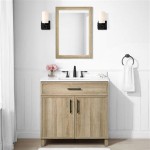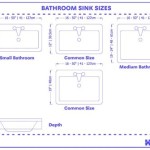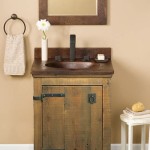Standard Depth of a Bathroom Linen Closet: A Comprehensive Guide
Bathroom linen closets are essential storage solutions in any home, providing a dedicated space for towels, toiletries, first-aid supplies, and other bathroom necessities. Optimizing space within these closets is crucial for maintaining an organized and functional bathroom. A significant factor in maximizing storage efficiency is understanding the standard depth of a bathroom linen closet. This article will provide a detailed exploration of standard depths, factors that influence depth selection, and considerations for designing and organizing a linen closet for optimal use.
The depth of a linen closet directly impacts what can be stored and how efficiently it can be accessed. A closet that is too shallow may not accommodate larger items, while one that is too deep can result in items being lost in the back and difficult to retrieve. Consequently, careful planning and consideration of standard depths are vital for effective bathroom storage.
Understanding Standard Linen Closet Depths
The standard depth for a bathroom linen closet typically falls within a range of 12 to 24 inches (30 to 61 centimeters). This range allows for accommodating various items, from folded towels to larger storage containers. However, a closer examination reveals that certain depths are more commonly used and considered more practical based on common bathroom dimensions and storage needs.
A depth of 12 inches (30 centimeters) is considered a minimal depth, often suitable for smaller bathrooms or closets intended primarily for storing hand towels, washcloths, and smaller toiletries. While a 12-inch depth can save space, it may not be deep enough to comfortably store larger bath towels or bulky items. This depth can be useful if space is at a premium and shallow shelves are preferred for easy visibility of all items.
A depth of 16 to 18 inches (41 to 46 centimeters) is often cited as a frequently used standard. This depth provides a good balance between storage capacity and accessibility. It allows for storing folded bath towels without excessive overhang and can accommodate standard-sized storage bins or baskets. The 16-18 inch range is versatile and adaptable to a variety of bathroom sizes and storage requirements.
A depth of 24 inches (61 centimeters) is the maximum depth commonly considered standard. This depth offers significant storage capacity, suitable for larger bathrooms or for homeowners who prefer to store a larger volume of items, including extra bedding, cleaning supplies, or even small appliances. However, a 24-inch depth can make it challenging to reach items at the back of the shelves, necessitating careful organization and potentially the use of pull-out shelves or baskets.
It is important to note that these are considered standard depths, and deviations are possible depending on the specific needs and space constraints of a particular bathroom. Custom-built linen closets can be tailored to virtually any depth, but adhering to standard dimensions can simplify the design process and potentially reduce costs.
Factors Influencing Linen Closet Depth Selection
Determining the optimal depth for a bathroom linen closet involves considering several factors, including the size of the bathroom, the types of items to be stored, and the desired level of accessibility. Ignoring these factors can result in a closet that is either too small to meet storage needs or too large, encroaching upon valuable bathroom space.
Bathroom Size and Layout: The overall size and layout of the bathroom are primary considerations. In smaller bathrooms, maximizing space efficiency is paramount. A shallower linen closet (12-16 inches) may be more appropriate to avoid making the room feel cramped. Larger bathrooms can more easily accommodate deeper closets (18-24 inches) without sacrificing space. The location of the closet within the bathroom also influences depth selection. A closet recessed into a wall may allow for a greater depth without impacting the usable floor space.
Types of Items to be Stored: The specific items intended for storage within the linen closet significantly impact the ideal depth. If the primary purpose is to store folded towels and toiletries, a depth of 16-18 inches may suffice. However, if larger items, such as extra blankets, pillows, or bulky cleaning supplies, are to be stored, a depth of 24 inches may be necessary. Consider the dimensions of the largest items to be stored when determining the appropriate depth.
Accessibility and Organization: The depth of a linen closet directly affects accessibility and organization. Deeper closets can quickly become disorganized if items are simply piled on top of each other. To maintain accessibility in deeper closets, consider implementing organizational strategies such as using shelf dividers, baskets, or pull-out shelves. These solutions can help to separate items and prevent them from being lost in the back of the closet. If accessibility is a primary concern, a shallower closet may be preferable, as it allows for easy visibility of all items.
Door Type and Clearance: The type of door used for the linen closet can also influence the perceived depth and accessibility. A standard hinged door requires sufficient clearance to swing open fully. In smaller bathrooms, a bi-fold door or a sliding door may be a better option to minimize the amount of space required for door operation. The door opening also affects how easily items can be retrieved from the closet. A wider door opening allows for easier access to items stored on the sides of the closet.
Aesthetic Considerations: While functionality is paramount, the aesthetic appeal of the linen closet should also be considered. The depth of the closet can affect its visual impact on the bathroom. A closet that is too deep may appear bulky or obtrusive, while one that is too shallow may look inadequate. Consider the overall design style of the bathroom and choose a closet depth that complements the existing aesthetic.
Furthermore, the internal configuration of shelves and drawers within the closet plays a crucial role. The placement and adjustability of shelves should be carefully considered based on the types of items to be stored. Adjustable shelves provide flexibility to accommodate items of varying heights. Drawers are useful for storing smaller items or items that need to be easily accessible. The depth of the drawers should also be considered in relation to the overall closet depth.
Designing and Organizing for Optimal Use
Once the appropriate depth for the bathroom linen closet has been determined, the next step is to design and organize the interior space for optimal use. A well-designed and organized linen closet can significantly improve storage efficiency and make it easier to find and access items when needed. Several design and organizational strategies can be employed to maximize the use of space.
Shelf Placement and Adjustability: The placement and adjustability of shelves are critical for maximizing storage efficiency. Adjustable shelves allow for customizing the spacing between shelves based on the height of the items to be stored. Place shelves closer together for storing smaller items and further apart for storing taller items. This minimizes wasted vertical space and allows for storing more items within the closet. Solid shelving material is advisable to prevent sagging, particularly in deeper closets. Opt for materials like MDF or plywood with a durable finish.
Utilizing Vertical Space: Vertical space is often underutilized in linen closets. Maximize vertical space by installing shelves that extend to the ceiling or by using vertical storage solutions such as over-the-door organizers or hanging shelves. These solutions are particularly useful for storing smaller items or items that are frequently used. Over-the-door organizers can be used to store toiletries, cleaning supplies, or accessories, while hanging shelves can be used to store folded towels or linens.
Storage Containers and Baskets: Using storage containers and baskets is an effective way to organize items within the linen closet and prevent clutter. Choose containers and baskets that are appropriately sized for the items to be stored and that fit comfortably on the shelves. Label each container or basket to identify its contents. This makes it easier to find items and prevents having to rummage through the entire closet to locate a specific item. Fabric-covered bins can add a touch of aesthetic appeal, while clear plastic bins offer visibility of the contents. Wicker baskets provide a natural and textured look.
Drawer Organization: If the linen closet includes drawers, consider using drawer dividers or organizers to separate items and prevent them from becoming jumbled. Drawer dividers can be used to separate toiletries, cosmetics, or small accessories. This makes it easier to find items and keeps the drawers tidy. Consider felt-lined drawer inserts to protect delicate items and prevent them from sliding around.
Lighting and Ventilation: Adequate lighting is essential for a functional linen closet. Install a light fixture inside the closet to provide visibility when searching for items. LED lighting is a good option as it is energy-efficient and produces minimal heat. Good ventilation is also important to prevent moisture buildup, which can lead to mold or mildew growth. Ensure that the closet is properly ventilated or consider installing a dehumidifier to control moisture levels.
Pull-out Shelves or Drawers: In deeper linen closets (24 inches), incorporating pull-out shelves or drawers can greatly improve accessibility to items stored at the back. These allow you to easily view and retrieve items without having to reach far into the closet. Pull-out shelves are particularly useful for storing bulky items such as blankets or linens. Consider adding soft-close mechanisms for a smooth and silent operation.
Door Organizers: Utilize the back of the linen closet door for additional storage using over-the-door organizers. These organizers can hold various items such as toiletries, cleaning supplies, or even shoe storage. They are an efficient way to maximize space in smaller linen closets.
Decluttering Regularly: Regularly decluttering the linen closet is essential for maintaining an organized and functional space. Remove items that are no longer used or needed. Donate or discard expired toiletries or cleaning supplies. This prevents clutter from accumulating and makes it easier to find the items that are actually used.
By carefully considering these design and organizational strategies, homeowners can create a bathroom linen closet that is both functional and aesthetically pleasing, regardless of its depth. The key is to tailor the design and organization to the specific storage needs and space constraints of the bathroom.

Pleasing Dimensions For A Linen Closet Home Decorating Design Forum Gardenweb Layout

Linen Closet Dimensions Impressive Lovely Check More At Https Acticin Com 43903 Dimen Design Layout

Appropriate Depth For Linen Closet

Veikous 23 6 In W X 11 8 D 31 H Freestanding Bathroom Linen Cabinets With Adjustable Shelf And 4 Drawer Gray Hp0904 01gy The Home Depot

How To Diy A Built In Linen Cabinet The Playbook

Easy Linen Closet Organization Ideas Julie Blanner

13 5 In W X 9 D 67 H Bathroom Linen Cabinet White 832810mdx The Home Depot

Easy Linen Closet Organization Ideas Julie Blanner

Teamson Home Glancy 15 In W X 13 D 63 H Bathroom Linen Storage Floor Cabinet With 2 Shutter Doors White Hdt588 The Depot
:max_bytes(150000):strip_icc()/Breathing-room-98afbc1dfdf4447aa5118c4bd2471cb9.jpg?strip=all)
Linen Closet Organization Ideas







